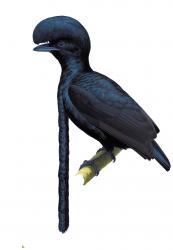| Long-wattled Umbrellabird | |
|---|---|
 Male | |
| Information | |
| Range | Pacific slopes of the Chocó of western Colombia and Ecuador. |
| Scientific Classification | |
| Kingdom | Animalia |
| Phylum | Chordata |
| Class | Aves |
| Order | Passeriformes |
| Family | Cotingidae |
| Genus | Cephalopterus |
| Species | Cephalopterus penduliger |
| Conservation Status | |
 Vulnerable | |
The Long-wattled umbrellabird (Cephalopterus penduliger), is a species of umbrellabird in the Cotingidae family.
Distribution[]
This species can be found in a relatively narrow belt along the Pacific slopes of the Chocó of western Colombia and Ecuador.
Habitat[]
The long-wattled umbrellabird lives in the canopies of tall trees in wet and humid forests at an elevation of 80–1,800 metres (260–5,910 ft) above sea level.
It is sensitive to habitat destruction, and its large size make it easy to hunt. Furthermore, only a few of the populations live within protected areas, so the bird is now considered vulnerable.
Description[]
The long-wattled umbrellabird is a large black bird with a body length reaching 51 centimeters in the males. Females are only about half the size of the males. In the males the head of these birds shows an impressive overhanging crest, extending over the bill, composed by hair-like feathers.
The bird's common name comes from the a long, inflatable wattle hanging from central chest of the male, which is up to 35 cm long and covered in short, scaly feathers. This wattle may be inflated during the elaborate courtship. In the females, by contrast, the wattle and the crest are reduced.
These birds are usually silent, but in breeding season, the males shout a loud call. The nest of this bird was first seen by scientists in 2003. Building the nest and brooding the chicks is in the sole responsibility of the female. The diet of the long-wattled umbrellabird is composed of insects, lizards and fruit, especially palm-nuts.
